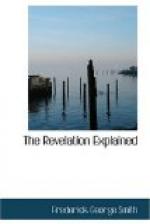16. Repent; or else I
will come unto thee quickly, and will
fight against them with the
sword of my mouth.
17. He that hath an ear, let him hear what the Spirit saith unto the churches; To him that overcometh will I give to eat of the hidden manna, and will give him a white stone, and in the stone a new name written, which no man knoweth saving he that receiveth it.
Pergamos was a city of considerable importance, the ancient metropolis of the province of Mysia and the residence of the Attalian kings.
The description here given of Christ is in accordance with the character of the church addressed and the work he found necessary to perform in it. They are said to be located “where Satan’s seat is.” Pergamos was a city reputed to be “sacred to the gods” and was one of the headquarters of idolatry. There are numerous such cities now among the Hindoos and other idolatrous nations. These cities are regarded with peculiar veneration and sanctity, and they contain the most honored temples. In the midst of such surroundings the influences against Christianity would be very great.
The congregation is commended because of its loyalty and steadfastness during a period of persecution in which Antipas was slain. When this persecution occurred, we are not informed; and as to the identity of Antipas, we are also left in uncertainty. Some suppose him to have been the elder of the church.
Christ censures them severely, however, for tolerating persons in their midst who held the doctrine of Balaam and the pernicious sentiments of the Nicolaitans, and he threatens to fight against them with the sword of his mouth unless they repent. The doctrine of Balaam is partly explained—he “taught Balak to cast a stumbling-block before the children of Israel, to eat things sacrificed unto idols, and to commit fornication.” When Balak desired Balaam to pronounce a curse against Israel, God by various means miraculously prevented Balaam’s doing so; but Balaam craftily instructed Balak to make use of the women of Moab to seduce the men of Israel to sacrifice to their idols and to indulge in the licentious accompaniments to such idolatry. In many places in heathen countries to-day vile women are attached to the temples of the gods, and at certain stated feasts licentiousness becomes a sanctioned part of the religious celebration. Balaam’s plan was successful. God was displeased with Israel, and because of this fornication there fell in one day twenty-four thousand. For a full account see Num. 22-25; 31:13-17.
It would appear that the doctrine of Balaam and the doctrine of the Nicolaitans were classed as two different heresies; but the corrupt tenets of the latter were identical with those of the former, and the probable meaning is, “As the Hebrews had Balaamites among them; so, likewise, you have among you the Nicolaitans teaching the same pernicious doctrines.” It is also a singular fact that the Hebrew signification of Balaam and the Greek of Nicolas is the same—“subduer of the people.” Thus the doctrine of Balaam would stand as a representation of the principles taught by the Nicolaitans.




